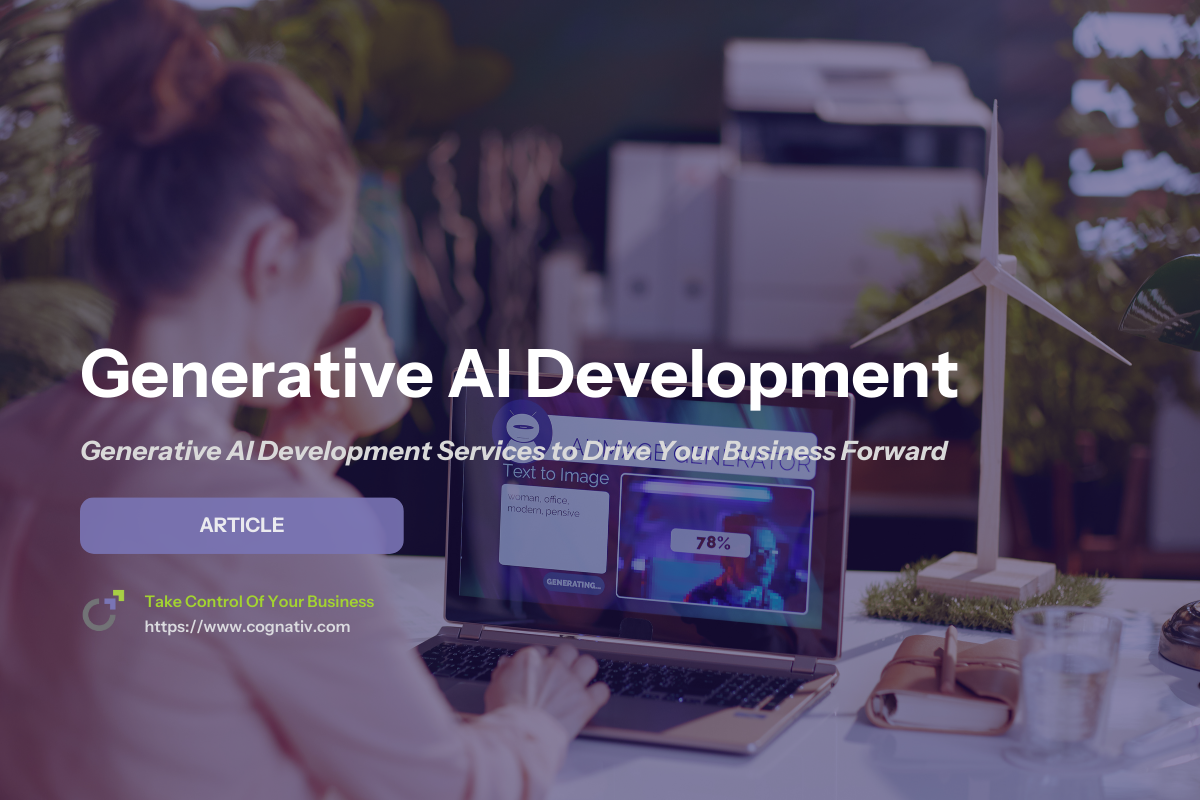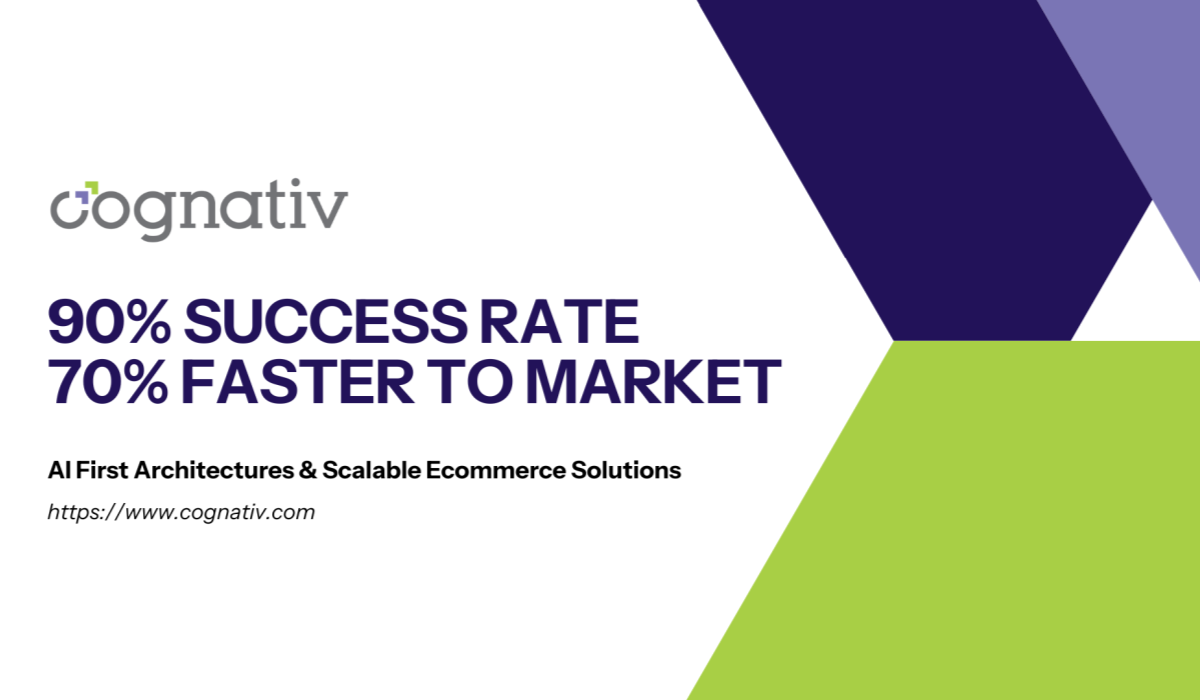

Thursday, September 18, 2025
Kevin Anderson
Generative AI Development Services to Drive Your Business Forward
Generative AI is the practical side of artificial intelligence that doesn’t just analyze information—it creates it. By learning the structure of existing data, modern generative AI models synthesize new text, images, code, and audio with remarkable fluency. For leaders, the value is simple: faster creation, smarter decisions, and experiences that feel tailored to every user.
A mature generative AI development company combines AI architecture, machine learning fundamentals, and platform integration to ship dependable features, not just demos. With strong ai development services—from data pipelines to MLOps—you get scalable, audit-ready, ai-driven solutions that compound value across teams and channels.

Benefits of Generative AI
Generative AI development enhances creativity and speed without sacrificing governance. When you embed generative AI into your workflows, you unlock:
Automation at scale: Drafts, summaries, translations, and code suggestions turn hours of effort into minutes.
Personalization: Gen AI solutions tailor messages, images, and offers by audience, journey stage, and device.
Consistency: Models learn braand voice, style, and policy rules, improving quality and reducing rework.
Decision support: Narrative analytics and scenario generation make complex choices clearer and faster.
Whether it’s marketing, service, finance, or product, the right ai solutions amplify your teams, boost productivity, and increase operational efficiency.

Generative AI Services and Applications
A capable partner delivers generative AI development services that span strategy through run-state. Common deliverables include discovery, data preparation, custom AI models, evaluation suites, and secure deployment. Typical applications:
Conversational assistants & chatbots: Natural, grounded dialogue that resolves more requests without handoffs.
Content creation & localization: Campaign assets, long-form articles, and microcopy generation with brand-safe guardrails.
Code generation & review: CI-integrated suggestions that reduce bugs and accelerate delivery.
Image generation & editing: On-brand visuals, product variants, and creative exploration at a fraction of the cost.
Scientific & domain work: Draft protocols, generate hypotheses, and speed annotation in R&D pipelines.
Across these, gen AI models open creative and operational possibilities that were impractical just last year.
Common Customer-Facing Use Cases
Lifecycle messaging: Personalized emails, in-app prompts, and landing pages that adapt per segment.
Support triage: Summaries, next-best actions, and escalation notes that shorten time to resolution.
Commerce: On-the-fly descriptions, bundles, and visuals tuned to shopper context.
Internal and Operational Use Cases
Analyst copilots: Synthesize reports, surface anomalies, and draft decision memos.
Engineering: Test stubs, docstrings, changelog summaries, and refactor hints.
Compliance: Policy-aware checks, explanations, and evidence packages for audits.

Generative AI Integration and Deployment
Value appears when generative AI works inside your existing systems. The best integrations feel invisible: a support agent drafts a reply in the ticketing tool, a merchandiser gets automated copy in the CMS, finance receives narrative forecasts in the BI dashboard. This is generative AI integration—tight adapters, clear policies, and stable endpoints so assistants can act, not just “chat.”
Integration patterns:
API orchestration: Assistants call approved tools with guardrails and audit trails.
Retrieval-augmented generation: Models cite from your knowledge base to reduce hallucinations.
Event-driven automation: Outputs trigger workflows, alerts, or approvals across platforms.
Latency tiers: Compact models answer fast paths; larger generative AI models handle deep reasoning.
With solid release hygiene, model training and fine-tuning continually lift accuracy in domain tasks (e.g., reading invoices, classifying medical images), while MLOps keeps deployments safe and reversible.

Developing Generative AI Capabilities
Durable capability requires more than clever prompts. You need sound AI architecture, strong machine learning practice, and platform fit. Generative AI developers select the right ai models, datasets, and policies—then validate with business stakeholders before scaling. Two accelerants stand out:
Synthetic data generation: Create rare or sensitive scenarios to de-bias training and stress-test safety.
Image generation: Produce on-brand visuals, backgrounds, and variants for campaigns and product catalogs.
Behind the scenes, ai development services provide the infrastructure—feature stores, evaluation harnesses, cost controls—so generative AI development becomes a repeatable advantage, not a one-off experiment.
Synthetic Data and Image Generation
Generate uncommon edge cases to harden safety and robustness.
Balance datasets for fairer outcomes during model training.
Create marketing concepts and UI mockups quickly for stakeholder review.

AI Development Process
Every successful program follows a disciplined ai development process grounded in short iterations and measurable outcomes.
Data Preparation
Data preparation turns existing data into reliable signals: cleaning, labeling, balancing, and PII scrubbing for text; consistent resizing and annotation for images. Clear provenance and access policies reduce noise so generative AI models learn the right patterns.
Model Training and Fine-Tuning
Engineers fine-tune foundation ai models with domain examples, reinforcement signals, and evaluation suites. Parameter-efficient methods hit accuracy, cost, and latency targets. Continuous tests track drift so quality doesn’t degrade after launch.
Model Deployment and MLOps
MLOps pipelines version datasets, prompts, and weights; enforce canaries and rollbacks; and log every decision for audit. This ensures generative AI development services scale safely across products, regions, and teams.
Custom Solutions for Every Business
No two organizations share the same constraints. That’s why custom generative AI solutions matter. Teams blend retrieval, policy engines, and custom AI models to match your tone, compliance, and brand. For creative groups, generative AI software development delivers plugins for design tools; for service, assistants summarize cases and propose actions; for product, narrative generators turn analytics into stories decision-makers can use. With experienced ai development services guiding the roadmap, companies earn a durable competitive edge.
Nearshore, Timezone-Aligned Talent
Proximity speeds delivery. Nearshore squads bring timezone overlap for workshops, pair-programming, and real-time reviews. Bilingual generative AI developers, often based in Latin America, join standups, share context with stakeholders, and iterate quickly—keeping momentum high while aligning with your internal rhythms.
Robust Security Measures
Security is a feature, not an afterthought. Generative AI solutions must protect sensitive data with encryption, strict access controls, environment isolation, and strong key management. Add comprehensive logging, continuous monitoring, and regular audits to verify that only authorized actions occur. Bias and ethics checks—plus adversarial testing—maintain integrity. And strict NDAs ensure confidentiality when collaborating with a generative AI development company.
Language Learning Models (LLMs)
Large language models (LLMs) like GPT-class transformers and BERT-style encoders interpret natural language and generate fluent outputs. They write, translate, summarize, and answer questions; grounded in your corpus, they become reliable copilots. A mature ai development company manages data collection, preprocessing, model design, training, and fine-tuning for optimal LLM performance—bringing generative AI capabilities to every surface.
Data Analysis and Interpretation
Strong data practice separates flashy demos from reliable systems. Data analysis ensures datasets are representative and bias-aware before training begins. After launch, A/B testing, trend analysis, and sentiment analysis refine prompts and policies so responses stay helpful. With ai development services providing dashboards and interpretation, leaders use evidence—not anecdotes—to steer investment and prioritize features.

The Generative AI Ecosystem
Think of the ecosystem as the scaffolding around your programs: development frameworks, model hubs, vector databases, orchestration layers, and policy engines. Proven expertise in this stack drives successful ai projects and faster delivery. By partnering with a capable generative AI development company, you assemble the right mix of generative AI models, ai tools, and platform components that fit your constraints and goals.

Key Trends and Insights
The trajectory is clear: organizations invest in generative AI to automate tasks, boost productivity, and personalize experiences. Many early deployments focus on support and marketing—drafting, summarization, campaign personalization—because payback is quick and measurable. Strategic teams also pair predictive analytics with generative AI to craft scenario narratives that help leaders choose with confidence. As infra matures, generative AI development services are shifting from pilots to platforms shared across business units.

Why Generative AI Development Companies Are Game-Changers?
Specialist partners accelerate the curve. A strong generative AI development company brings reference architectures, evaluation suites, and delivery playbooks that reduce risk.
They help you select the right ai models, deploy generative AI systems responsibly, and expand capability across units. By extracting insights from data and packaging them as ai-driven solutions, these companies unlock hidden opportunities and fuel efficiency and growth.

How to Choose the Right Generative AI Development Company?
Selecting a partner is a strategic decision.
Evaluate
Expertise & proven track record: shipped products at scale, not just prototypes.
Tailored delivery: ability to design generative AI development services aligned with your business needs.
Technology fit: compatibility with your cloud, data posture, and security model—plus scalability for future growth.
Client feedback & domain experience: references in your industry.
Responsible AI: safety, privacy, and governance policies built into the operating model.

Generative AI Solutions and Consulting
Whether you’re drafting strategy or building production features, generative AI solutions plus seasoned consulting shorten time to value. Partner teams design competitive, functional applications—assistants, generators, analyzers—then coach your staff to operate them. This model pairs ai development with enablement so capability endures after the first release. If your roadmap calls for platformization, consultants evolve pilots into reusable services others can adopt quickly.

Generative AI Integration and Deployment: Real-World Patterns
To integrate generative AI solutions safely, keep humans in the loop for high-impact actions, ground generations in trusted data, and record decisions for audit. Map actions to approvals, define rollbacks, and put quotas around expensive operations. The result is dependable generative AI development that scales without surprises.

Developing Generative AI Capabilities: Building Blocks
Core building blocks include retrieval services, prompt libraries, policy engines, telemetry, and evaluation harnesses. With these in place—and a strong ai development cadence—new features ship faster, costs stay predictable, and quality improves release by release.

The Role of Generative AI Talent
People power the transformation. Skilled generative AI developers and architects use advanced algorithms, large language models, and evaluation science to build robust systems. Whether you hire or partner with a generative AI development company, invest in talent that understands safety, performance, and change management—not just prompts.

The Importance of AI Projects
Every program is a series of scoped ai projects with clear outcomes, budgets, and evidence. Plan carefully, execute iteratively, and monitor relentlessly. Remember that ai development services provide the infrastructure to deploy scalable ai-driven solutions—turning experimentation into a dependable capability that advances the business quarter after quarter.
Next Steps in Generative AI
Start small, prove value, and scale deliberately. Pick a high-volume journey with clear owners and KPIs; launch a thin slice with human oversight; then generalize patterns. Over time, codify shared components—retrieval, red-teaming, prompt libraries—so new teams ship faster. The future of generative AI is promising and practical, and ai development services will continue to be the scaffolding that turns strategy into impact.

